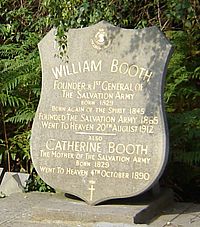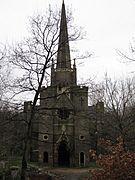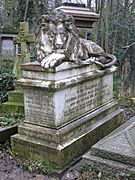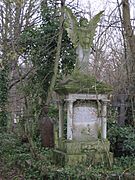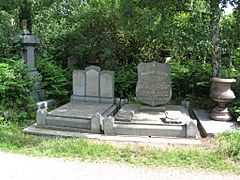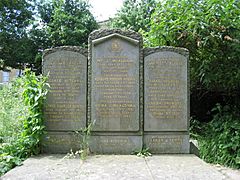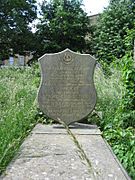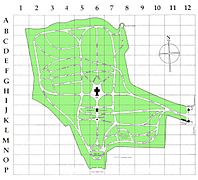Abney Park Cemetery facts for kids
 |
|
| Details | |
|---|---|
| Established | 1840 |
| Location |
London
|
| Country | United Kingdom |
| Type | Public |
| Owned by | London Borough of Hackney |
| Size | 12.53 hectares (31 acres) |
| No. of interments | around 200,000 |
Abney Park Cemetery is one of the famous "Magnificent Seven" cemeteries in London, England.
Abney Park is in Stoke Newington in the London Borough of Hackney. It is a historic park that was first designed in the early 1700s. Lady Mary Abney and Dr. Isaac Watts helped create it.
In 1840, it became a special kind of cemetery called a garden cemetery. This meant it was open to people of all faiths. It was also a public park and a place for learning about trees (an arboretum). Over 196,000 burials have happened there. Today, it is a Local Nature Reserve, which means it protects local wildlife.
Contents
- Finding Abney Park
- A Look at Abney Park's History
- The Egyptian Style Entrance
- A Unique Landscape
- The "Sacred Field" of Dissenters
- Learning and Education
- Famous People Buried Here
- World Wars and Memorials
- Nature and Wildlife
- A Visitor's Account
- Gallery
- Abney Park in Pop Culture
- Getting There
- Images for kids
Finding Abney Park
The official address for Abney Park is Stoke Newington High Street, N16. The main entrance is where this street meets Rectory Road. There is also a smaller gate on Stoke Newington Church Street.
The park is located in the London Borough of Hackney. The closest train station is London Overground's Stoke Newington railway station. It is only 200 metres from the main entrance.
A Look at Abney Park's History
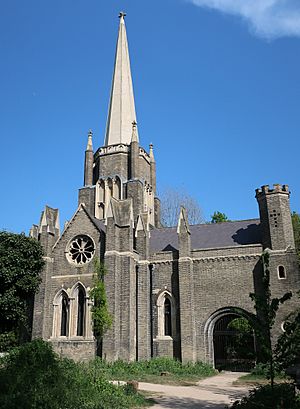
The cemetery is named after Sir Thomas Abney. He was the Lord Mayor of London in 1700–1701. His large house, Abney House, was built in 1676. It stood where the cemetery is now until it was taken down in the 1830s.
In 1840, Abney Park opened as a new type of cemetery. It was designed as a beautiful garden. It was special because it was the first cemetery in Europe that was open to everyone, no matter their religion. This idea came from the Congregational church and American cemeteries like Mount Auburn Cemetery.
Over time, the park's focus shifted more towards being just a cemetery. In the 1970s, the company that ran the cemetery closed down. In 1978, the local council took over the park. For many years, nature was allowed to grow freely.
Abney Park was added to the Heritage at Risk Register in 2009. This means it's a historic site that needs care. Staff and volunteers work hard to keep the park safe and beautiful. They also hold many events there. The park's central Abney Park Chapel has been damaged over time. However, Abney Park is still a very popular place to visit. It is a designated Local Nature Reserve and Conservation Area.
The park covers about 12.5 hectares (30 acres). It has a nature reserve, a classroom, and a visitor's centre. The central chapel is no longer used. The park is usually open for free every day from about 9:30 am to 5 pm.
The Egyptian Style Entrance
Abney Park is one of the "Magnificent Seven" cemeteries from the Victorian period. Its entrance was designed by William Hosking and Joseph Bonomi the Younger. It was built in the popular Egyptian Revival style. This style uses designs inspired by ancient Egypt.
The entrance has hieroglyphics, which are ancient Egyptian symbols. They mean "Abode of the Mortal Part of Man." This design was very new for the time. Some people, like Augustus Pugin, didn't like it. They thought it was too different from traditional Christian Gothic designs. However, others praised it.
Abney Park's entrance might be the first complete, permanent Egyptian Revival entrance for a cemetery anywhere in the world. It was built before the permanent entrance at Mount Auburn Cemetery, which inspired it.
The Egyptian style was chosen for a special reason. Abney Park was the first garden cemetery in Europe that was completely non-denominational. This meant it had "no dividing lines" between different religious groups. Even its chapel, the Abney Park Chapel, had only one main room for everyone to use. This made it the first non-denominational cemetery chapel in Europe.
Today, Abney Park continues its role as both a park and a cemetery. Burials stopped in 1978. Now, the park hosts many activities. These include arts, education, nature conservation, and walking. People can also scatter ashes here and occasionally have special burials.
A Unique Landscape
Abney Park was the first place in Europe to combine an arboretum (a collection of trees) with a cemetery. It was an educational attraction. Its 2,500 trees and shrubs were all labeled. They were arranged alphabetically around the edges, from A for Acer (maple trees) to Z for Zanthoxylum (American toothache trees).
This focus on education was admired by John Claudius Loudon. He called it "the most highly ornamented cemetery in the vicinity of London." The design aimed to keep the natural beauty of the existing parkland.
The idea for the arboretum came from George Loddiges. He was a local plant nursery owner. He had one of the largest collections of trees and shrubs in Britain. He helped design the landscape and label the plants. Sadly, Loddiges Nursery closed in the 1850s. This made it harder to maintain the trees and labels.
Today, Loddiges' work is very important for landscape design. Abney Park was the first London cemetery invited to join the Association of Significant Cemeteries in Europe. It is the only surviving example of an English landscape designed by Loddiges.
The "Sacred Field" of Dissenters
The founders of Abney Park Cemetery were Nonconformists. These were Protestants who practiced Christianity outside the official Church of England. They believed the land was very special. It used to be the estates of Abney House and Fleetwood House. The famous non-conformist writer and poet Dr. Isaac Watts lived and taught there.
Because of these religious connections, Abney Park Cemetery became a popular resting place for nonconformist ministers and educators. It is now the most important burial place in the UK for 19th-century Congregational, Baptist, Methodist, and Salvation Army leaders.
While it attracted many nonconformists, Abney Park Cemetery was open to everyone. Its founders wanted it to be the first fully non-denominational cemetery in Europe. This meant anyone could be buried anywhere. The choice of a site linked to Dr. Isaac Watts helped this goal. He was respected by many different faiths.
The Abney Park Chapel became the spiritual heart of the cemetery. A path called Dr. Watts' Walk leads to it. In 1845, a public statue of Dr. Watts, sculpted by Edward Hodges Baily, was placed there.
Learning and Education
Abney Park has a strong connection to education. For example, Charles Reed, a director of the cemetery, was also the Chairman of the London School Board. This part of north London, especially Newington Green, had a long history of new ways of teaching.
Abney House was the first place in England used only as a Wesleyan training college. This was from about 1838 until 1843, when the college moved.
Next to Abney House was Fleetwood House. This was home to the Newington Academy for Girls, founded in 1824. This school was run in a very modern way. The students could use the new cemetery's educational arboretum. The school even had the first school bus in the world!
Famous People Buried Here
Many important people are buried at Abney Park.
- Founders of The Salvation Army: William and Catherine Booth are buried in a special spot. Their son, Bramwell Booth, and other Salvation Army leaders are also nearby.
- Anti-Slavery Activists: Many people who fought to end slavery are here. These include Thomas Binney, Christopher Newman Hall, and James Sherman. The grave of Olaudah Equiano's daughter, Joanna Vassa, was recently found here. Aaron Buzacott, a secretary of Anti-Slavery International, is also buried here.
- Early Settlers: Some of the first people from other parts of the world to settle in Britain are buried here. This includes Thomas Caulker, the son of a king from Sierra Leone, and Leota from the Samoa Islands.
- Missionaries: Many 19th-century missionaries are buried here. Examples include William Ellis and Walter Henry Medhurst.
- Politicians and Educators: Sir Charles Reed, a Member of Parliament, is buried here. His father, Dr Andrew Reed, who founded the London Orphan Asylum, is also here. The Welsh MP Henry Richard, who helped start the first university in Wales, is buried here.
- Other Notable Figures:
* Betsi Cadwaladr, a Welsh nurse who worked with Florence Nightingale in the Crimea. * James Braidwood, who helped form the first municipal fire brigade. * Artists like Edward Calvert and Isabella Banks. * The Chartist leader James "Bronterre" O'Brien. * Mary Hays, a feminist writer. * Eric Walrond, an African-American writer. * Private John Freeman, a Victoria Cross recipient. * Tommy Hall, a world record-holder in cycling. * William Calcraft, a public hangman. * Susanna Bostock, known for bringing exotic animals to the public. Her grave has a life-sized marble lion.
- Theatre and Music Hall Performers: Many famous performers are buried here. These include George Leybourne, Nelly Power, and Albert Chevalier. A charity helps care for their graves.
World Wars and Memorials

Abney Park has war graves for 371 Commonwealth service members. These are people who died in World War I (258) and World War II (113). The Commonwealth War Graves Commission looks after these graves.
There are two "Cross of Sacrifice" monuments in Stoke Newington. One is in Abney Park. It honors those buried in the cemetery whose graves could not have individual headstones. There is also a small memorial for civilians who died in the Blitz during World War II. This memorial lists many people who died in one incident on October 13, 1940, when a bomb hit a shelter.
Nature and Wildlife
Abney Park Cemetery was the only garden cemetery of its time influenced by American cemetery designs. It was inspired by Mount Auburn Cemetery. Abney Park was designed to be very natural, with many trees.
Over time, Abney Park has become a beautiful woodland cemetery. By the early 1990s, it was recognized as the largest woodland ecosystem in North London close to the city center. It became the first official Local Nature Reserve in Hackney.
The woodland is growing richer through natural processes. The northern areas are returning to native oaks and hornbeams. The sandy soils near Church Street are becoming silver birch woodlands. Today, the park supports many woodland birds, mammals, and butterflies. It is one of North London's largest breeding sites for species like the speckled wood butterfly.
Caring for this natural environment is important. This helps keep the park's unique beauty and educational value.
A Visitor's Account
Here is part of a Victorian story about visiting Abney Park Cemetery:
There is a beautiful cemetery in Stoke Newington. It was given to the people in memory of Lady Mary Abney, who was a true friend to Dr. Watts. It has a lovely small church where funeral services are held for all Christians.
Lady Abney was very open-minded about religion. The cemetery and its church are open to everyone. Even though the grounds were never officially blessed, many strict church members have been buried there. It is the quietest burial place within many miles of London. It has cedars of Lebanon, wide lawns, and beautiful flowers.
There is an old clergyman in the church. He is always ready to lead funeral services for a small fee. He is over eighty years old, with hair like snow. He fits perfectly in such a solemn place.
One bright evening, my friend and I visited the cemetery. We stopped in the small Gothic Abney Park Chapel to talk with the old clergyman. Tears came to his eyes when we said we were from America.
The old man asked many questions about the wonderful land of liberty in the west, which we were happy to answer. Almost every poor but respectable family in England has a family member or relative in America.
Gallery
Abney Park Cemetery is one of the Magnificent Seven. It is one of the five cemeteries north of the River Thames.
-
View of the Gothic Chapel from the War Monument
-
Graves of General William Booth, Catherine Booth and the Commissioners (Grave O06:103244)
-
Grave of General Bramwell Booth and Florence Booth (Grave O06:133223)
-
Salvation Army Marker for Bramwell Booth and his wife Florence Booth
Abney Park in Pop Culture
Abney Park Cemetery has appeared in many movies, TV shows, and music videos:
- The music video for "Back to Black" by Amy Winehouse was filmed here.
- The Steampunk band Abney Park is named after the cemetery.
- It's the setting for a murder in Elizabeth George's book The Body of Death.
- It was used to look like Highgate Cemetery in the TV show Waking The Dead.
- The music video for "Celestica" by Crystal Castles was filmed here.
- In Michelle Lowe's steampunk novel Legacy: Volume One, the cemetery is where the main characters are separated from their family.
- The music video for "Johnny Remember Me" by John Cooper Clarke and Hugh Cornwell was filmed entirely here.
- The band Sundara Karma filmed their music video for "Explore" at Abney Park Cemetery.
Getting There
- Train: Stoke Newington railway station is very close.
- Underground: The nearest London Underground station is Manor House (about 2 km away) on the Piccadilly line.
- Buses: Routes 73, 67, 76, 106, 243, 276. Route 73 is recommended from the West End.
- Walking: The Capital Ring, a long walking route, passes by the park.
- Bicycle: There is bike parking at the Church Street entrance.
- Disabled Access: The main entrance has disabled access.
Images for kids




